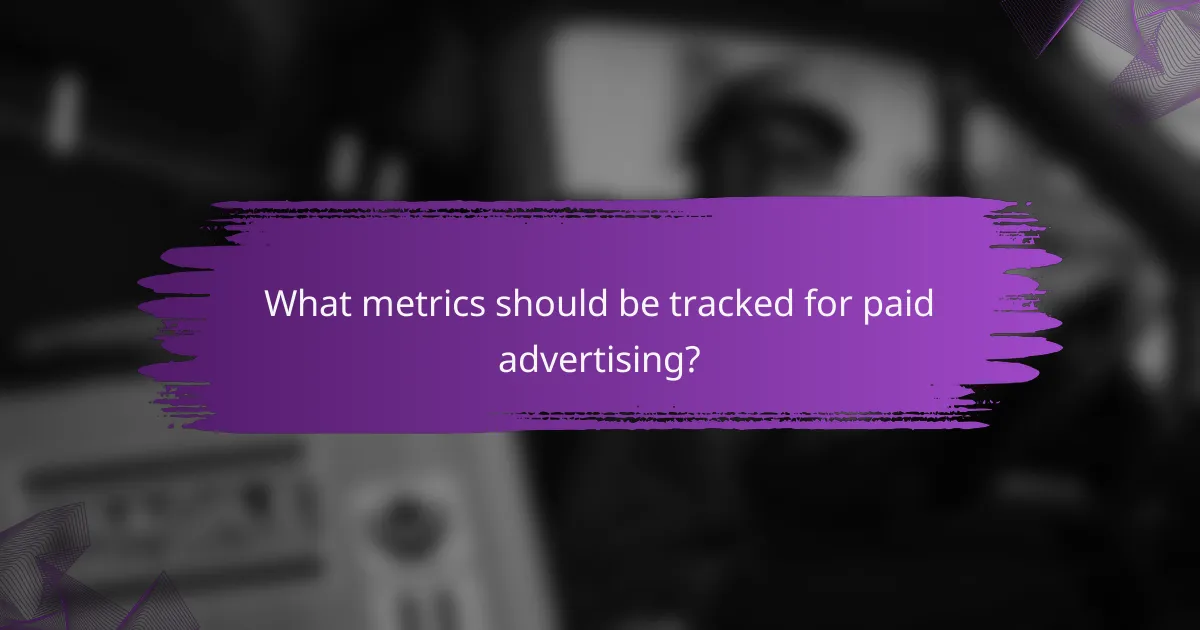Paid advertising is a crucial component of modern marketing, allowing businesses to effectively promote their products and services through various financial strategies. With options like search, display, social media, video advertising, and affiliate marketing, companies can tailor their approach to reach specific audiences and achieve their goals. Selecting the right platform, such as Google Ads or Facebook Ads, is essential for maximizing the impact of these advertising efforts.

What are the types of paid advertising?
Paid advertising encompasses various strategies that businesses use to promote their products or services through financial investment. The main types include search advertising, display advertising, social media advertising, video advertising, and affiliate marketing, each with unique characteristics and benefits.
Search advertising
Search advertising involves placing ads on search engine results pages, targeting users actively seeking specific information or products. Advertisers bid on keywords relevant to their offerings, and ads appear when users search those terms.
To maximize effectiveness, focus on high-intent keywords that align with your audience’s needs. Tools like Google Ads allow for budget control and performance tracking, making it easier to adjust strategies based on results.
Display advertising
Display advertising uses visual ads, such as banners and images, placed on websites, apps, or social media platforms. These ads aim to capture the attention of users as they browse content online.
Consider targeting specific demographics or interests to enhance engagement. Display ads can be bought through networks like Google Display Network, allowing for broad reach while providing options for retargeting potential customers who have previously interacted with your brand.
Social media advertising
Social media advertising leverages platforms like Facebook, Instagram, and Twitter to promote products to targeted audiences. Advertisers can create various ad formats, including sponsored posts, stories, and carousel ads, tailored to the platform’s unique user experience.
Utilize audience segmentation tools to reach specific groups based on interests, behaviors, and demographics. Regularly analyze engagement metrics to refine your approach and optimize ad spend for better returns.
Video advertising
Video advertising involves using video content to promote products or services, often displayed on platforms like YouTube or social media. This format can be highly engaging, allowing brands to tell compelling stories or demonstrate products effectively.
Consider the length and placement of your videos to maximize viewer retention. Short ads (15-30 seconds) tend to perform well, especially on social media, while longer formats may be suitable for YouTube where users expect more in-depth content.
Affiliate marketing
Affiliate marketing is a performance-based advertising strategy where businesses pay affiliates to promote their products. Affiliates earn a commission for each sale or lead generated through their marketing efforts, creating a win-win situation.
To implement affiliate marketing successfully, choose affiliates whose audiences align with your target market. Establish clear terms and conditions, and provide affiliates with the necessary tools and resources to promote your products effectively.

How to choose the right paid advertising strategy?
Choosing the right paid advertising strategy involves understanding your target audience, setting clear objectives, and analyzing competitor strategies. These steps help ensure that your advertising efforts are effective and aligned with your business goals.
Define target audience
Defining your target audience is crucial for selecting an effective paid advertising strategy. Identify demographics such as age, gender, location, and interests to tailor your messaging and platform choices. For instance, if your product appeals to young adults, platforms like Instagram or TikTok may be more effective than LinkedIn.
Utilize tools like Google Analytics or social media insights to gather data on your existing audience. This information can guide your ad targeting, ensuring you reach those most likely to engage with your content.
Set clear objectives
Setting clear objectives is essential for measuring the success of your paid advertising strategy. Determine what you want to achieve, whether it’s increasing brand awareness, generating leads, or driving sales. Specific objectives help in selecting the right metrics to track performance.
For example, if your goal is to boost sales, focus on metrics like conversion rates and return on ad spend (ROAS). Conversely, for brand awareness, impressions and reach may be more relevant. Ensure your objectives are SMART: Specific, Measurable, Achievable, Relevant, and Time-bound.
Analyze competitor strategies
Analyzing competitor strategies provides valuable insights into what works in your industry. Research their ad placements, messaging, and engagement levels to identify successful tactics. Tools like SEMrush or SpyFu can help you view competitor ads and keywords.
Consider what differentiates your product or service from theirs and how you can leverage that in your advertising. This analysis can reveal gaps in the market or opportunities for unique positioning, allowing you to craft a more effective strategy.

What are the most effective platforms for paid advertising?
The most effective platforms for paid advertising include Google Ads, Facebook Ads, LinkedIn Ads, Instagram Ads, and Twitter Ads. Each platform has unique strengths and audience demographics, making them suitable for different marketing objectives.
Google Ads
Google Ads operates on a pay-per-click model, allowing advertisers to bid on keywords to display ads in search results and on partner sites. It is particularly effective for businesses looking to capture intent-driven traffic, as users often search for specific products or services.
To maximize effectiveness, focus on keyword research and ad copy that aligns with user queries. Consider using ad extensions to provide additional information, such as location or contact details, which can improve click-through rates.
Facebook Ads
Facebook Ads offer robust targeting options based on user demographics, interests, and behaviors. This platform is ideal for brand awareness and engagement, allowing businesses to reach a wide audience through visually appealing ads.
Utilize A/B testing to refine your ad creatives and messaging. Keep in mind that video content often performs better than static images, so consider incorporating videos to enhance engagement.
LinkedIn Ads
LinkedIn Ads are tailored for B2B marketing, targeting professionals based on job title, industry, and company size. This platform is effective for lead generation and promoting services to a business audience.
Sponsored content and InMail campaigns can be particularly effective. Ensure your messaging is professional and relevant to the audience’s needs, and consider using LinkedIn’s analytics tools to track campaign performance.
Instagram Ads
Instagram Ads leverage visually-driven content to engage users, making it an excellent choice for brands in fashion, beauty, and lifestyle sectors. The platform supports various ad formats, including stories, carousel ads, and shopping posts.
Focus on high-quality visuals and authentic storytelling to resonate with users. Utilize Instagram’s shopping features to streamline the purchasing process directly from ads, enhancing conversion rates.
Twitter Ads
Twitter Ads allow businesses to promote tweets and accounts to increase visibility and engagement. This platform is effective for real-time marketing and reaching audiences during trending events or conversations.
Consider using promoted trends or hashtags to boost visibility. Keep your messaging concise and engaging, as Twitter’s character limit necessitates clear and impactful communication.

What metrics should be tracked for paid advertising?
Tracking the right metrics for paid advertising is crucial for understanding campaign performance and optimizing return on investment. Key metrics include Return on Ad Spend (ROAS), Click-Through Rate (CTR), and Conversion Rate, each providing insights into different aspects of your advertising effectiveness.
Return on ad spend (ROAS)
Return on Ad Spend (ROAS) measures the revenue generated for every dollar spent on advertising. To calculate ROAS, divide the total revenue from ads by the total ad spend. A common target for many businesses is a ROAS of at least 4:1, meaning for every dollar spent, four dollars are earned.
When analyzing ROAS, consider the context of your industry and profit margins. High-ticket items may allow for a lower ROAS, while low-margin products typically require a higher ROAS to be profitable. Regularly review and adjust your campaigns based on ROAS to ensure optimal performance.
Click-through rate (CTR)
Click-Through Rate (CTR) indicates the percentage of users who click on your ad after seeing it. To calculate CTR, divide the number of clicks by the number of impressions and multiply by 100. A good CTR varies by industry, but generally, a rate above 2% is considered effective.
Improving CTR can involve refining ad copy, targeting the right audience, and using compelling visuals. Monitor CTR closely, as a low rate may suggest that your ads are not resonating with your audience or that your targeting needs adjustment.
Conversion rate
The Conversion Rate measures the percentage of users who complete a desired action after clicking on your ad, such as making a purchase or signing up for a newsletter. To calculate it, divide the number of conversions by the number of clicks and multiply by 100. A typical conversion rate ranges from 1% to 5%, depending on the industry and campaign type.
To enhance conversion rates, focus on optimizing landing pages, ensuring a seamless user experience, and providing clear calls to action. Regularly test different elements, such as headlines and images, to identify what drives the best results for your campaigns.

